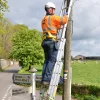Wales Could Unveil New Superfast Broadband Rollout Plan Next Week
The Welsh Government (WG) has suggested that it will next week publish information on new rollout plan for “superfast broadband” (30Mbps+) services, which could set out their strategy for extending related networks to cover the whole of Wales (benefiting approximately 98,145 additional premises).
At present fibre-based broadband services are already estimated to cover approximately 97% of premises (homes and businesses), yet networks that can deliver speeds of 30Mbps+ are only available to around 93-94% (here). Much of this delivery has been supported by around £225m of public funding via the Superfast Cymru project with Openreach (BT), which has been rolling out a mix of FTTC and some ultrafast FTTP.
Unfortunately this means that Wales finds itself running a smidgen behind the wider 95%+ coverage aspiration for “superfast broadband.” In response a number of Assembly Members (AMs) have already put the blame for this squarely at Openreach’s feet (example), although in fairness the operator has faced plenty of difficult issues (e.g. problems with securing access to land via wayleave agreements).
Advertisement
The original contract is now coming to an end and meanwhile the WG has been busy working on a new programme to follow it, which in 2016 proposed to put £80 million of public funding toward extending “fast reliable broadband” (defined as 30Mbps+) to “every property” in Wales by 2020 (here and here).
Provisional £80m Funding Breakdown
* £20m committed in the recent Welsh Government budget over the next 3-4 years.
* £20m from European structural funds, subject to WEFO approval.
* £37m from gain-share as a result of take-up of superfast broadband (i.e. public money returned by BT due to clawback).
* £2m outstanding commitment from UK government towards the new superfast broadband project.
Today the WG confirmed that their plan for the new project would be unveiled next week.
Julie James AM, Leader of the House and Chief Whip, said:
“I intend to carry out a procurement exercise shortly, with a view to the new project starting in spring this year. I’ll be making a statement later this month to set out more detail about the new scheme.
We won’t know for a number of weeks yet whether the contract was completely fulfilled, but we have good indications that they did very well, and we’re very hopeful that they did in fact fulfil the contract.
I will be making an announcement early next week, so I’m going to avoid the temptation to steal my own thunder by pre-announcing it, but we are very aware of the predicament of communities who’ve been left there, and of the number of people who were promised superfast under the first scheme and who fell off the end for various reasons.
We very much have those people in mind when we’re looking at the announcements that I’m hoping to make early next week, as it happens.”
The existing commitment of £80m equates to roughly £816 per property and we assume that this will end up being supported by match-funding from other sources, such as the private sector. Nevertheless there will be quite a few premises in Wales that cost considerably more to reach and this raises the question of whether enough funding exists to complete the work (reaching remote rural areas tends to be disproportionately more expensive).
Naturally a shortage of funding could result in the WG adopting cheaper solutions, such as inferior Satellite connectivity, to reach some of the most remote premises and we may also see a greater acceptance of fixed wireless broadband platforms. All of this may be good news for smaller alternative network (altnet) providers but we’ll have to wait and see how flexible the plan is.
Advertisement
On top of that there’s still a lot of uncertainty around the UK Government’s final approach toward its proposed 10Mbps+ Universal Service Obligation (USO), which could have an impact upon proposed projects like the one in Wales and Scotland.
The project in Wales has actually made some impressive progress over the past few years, particularly given some of the challenges involved with reaching the more remote and sparse rural communities. Nevertheless this will be of little consolation to those who have spent the past decade stuck in the broadband slow lane and they’ll be watching next week’s announcement for an answer.
Mark is a professional technology writer, IT consultant and computer engineer from Dorset (England), he also founded ISPreview in 1999 and enjoys analysing the latest telecoms and broadband developments. Find me on X (Twitter), Mastodon, Facebook, BlueSky, Threads.net and Linkedin.
« Ofcom Fine ISP Gateway Telecom £20K for Preventing Number Ports
Sky Reports UK Growth in Mobile and Broadband for H1 2018 »


















































Comments are closed